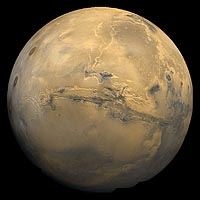 |
Because its orbit is very elliptical, Mars’ climate ranges are dramatic. It’s average overall temperature is -67 F, but surface temperatures range from -207F at the winter pole to 80F during the summer!
It’s terrain is also very diverse. It is much smaller than Earth, but its surface area equals that of the land area of Earth. A ‘terrestrial’ or ‘rocky’ planet, like Mercury, Venus, and Earth, it has a high density, rotates slowly and has no rings and few satellites (Earth has the moon, Mars has Phobos and Deimos). It has a solid surface and is composed primarily of rock and metal. Much of it is cratered, but this interesting planet also holds some very unique topographical features. Amongst those are: Olympus Mons, the largest mountain in the Solar System rising 78,000 ft (!), Tharsis, an enormous bulge almost 2500 miles wide and 6 miles high, Valles Marineris, a series of canyons apx. 2500 miles wide, and Hellas Planitia a gigantic impact crater nearly 4 miles deep and over 1200 miles wide!
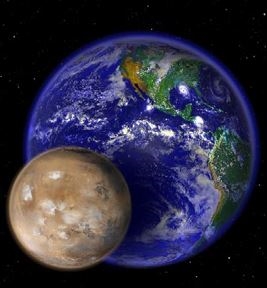 |
Another key reason why extraterrestrial life is considered a possibility, is that there is clear evidence of erosion on Mars, including river systems and flood valleys, showing that at some point there was some sort of fluid on its surface. Scientists feel that there may have even been oceans or large lakes, and some images show what seems to be a frozen sea, that was liquid within the last few million years. Mars also has permanent ice caps on its poles, made up of water ice and ‘dry ice’ (solid carbon dioxide).
Like Earth, Mars is also home to many volcanoes, but Martian volcanoes are much larger -- in some cases, 100 times so! Likewise, scientists are also particularly interested in studying the age and makeup of the lava and rocks on the surface of Mars, using them to determine the events in the history of the planet. Rocks and minerals which were formed in the presence of water are of key importance, as again, they may hold signs of previous life.
Mars’ atmosphere is different than Earth’s, as it is 100 times thinner and made up of a small amount of carbon monoxide (which yet makes up 95.3% of it), in addition to nitrogen, argon, oxygen and water. Earth is affected by weather and wind patterns, but Mars is particularly so. There are sometimes very strong winds and intense dust storms that are known to superficially engulf the entire planet for months at a time!
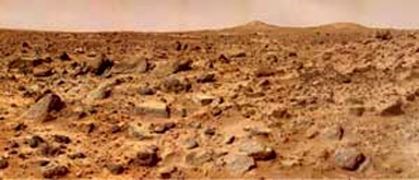 |
These days Mars is a key topic of study amongst scientists worldwide. As evidenced above, we humans want to know if it is possible that any forms of life exist on Mars now, or have at any point in time. And if there was life on Mars once... what happened to it?
For as much as Earth is an inhabitable planet, where such a great variety of life forms exist and thrive, there are areas on Earth that are considered “harsh” as well, either for their climate, their chemical or gaseous consistencies, etc., and not necessarily condusive to life. In fact, many of these places were at various points in history, thought to house no life at all.
And yet some life forms, oftentimes microscopic ones, are still able to survive, and thrive there. Hence, if life is present in even the harshest of the Earth’s environments, the same may be the case for Mars!
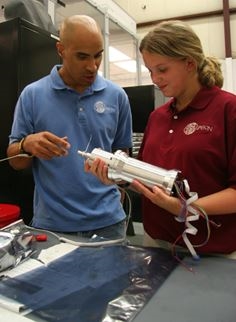 |
| NASA Senior Mechanical Engineer, Kobie Boykins, shows Student Argonaut Janelle Wilson a part of the Mars rover. Wilson was at NASA Jet Propulsion Laboratory, where the Mars rovers Spirit and Opportunity were designed, as part of the JASON Expedition: Mysteries of Earth and Mars. |
From the alkaline and ultra-salty waters of Mono Lake, California to the volcanic surface of Hawai`i Volcanoes National Park, to the wonderous Meteor Crater in Arizona, as well as NASA's Jet Propulsion Laboratory in California, JASON’s team of student and teacher “Argonauts,” host researchers, and scientists compared the geology of Earth and Mars, used micro and molecular biology to study life forms, examined the forces that have shaped the Martian surface, and investigated the challenges of robotic space exploration -- integrating science, adventure, exploration, and fun!
Page created on 10/5/2007 2:46:31 PM
Last edited 10/5/2007 2:46:31 PM
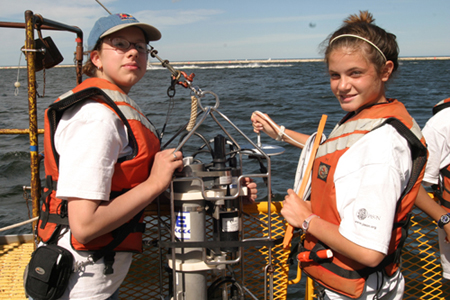
Student Argonauts Anna Dykhoff (LEFT) and Megan Shaffer(RIGHT) researching water quality as part of the Jason Expedition program. They are on the research vessel NEESKAY on Lake Michigan. Dykhoff is a ninth grade homeschooler from Virgina. Shaffer is a ninth grader from Maryland.
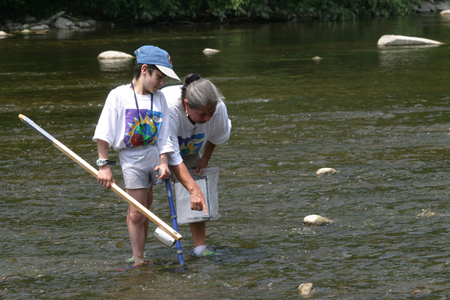
Science teacher Lollie Garay (RIGHT), a science teacher from Texas, with student Argonaut Alexander Garrett (LEFT) from New York. They are researching water quality as part of the JASON Expedition program.
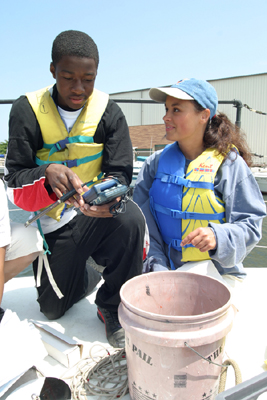
Science teacher Danielle Renz (RIGHT), a science teacher from Wisconsin, with student Argonuat Chris Scarver, also from Wisconsin, researching water quality as part of the JASON Expedition program.
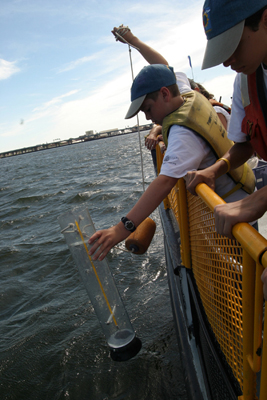
Student Argonaut Andrew Young researching water quality as part of the JASON Expedition program. He is taking water samples in Lake Michigan on the research vessel NEESKAY. Young is a ninth grader from Ohio.
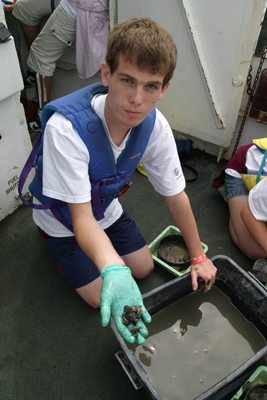

For over a decade JASON Expeditions have taken place around the globe.

Summer of 2005's JASON Project expedition, “Mysteries of Earth and Mars,” explored several different locations around the United States. The student and teacher “Argonauts," along with a team of renowned researchers and scientists, helped "unravel the mysteries of Earth and Mars" as they compared the two planets through exciting scientific exploration!